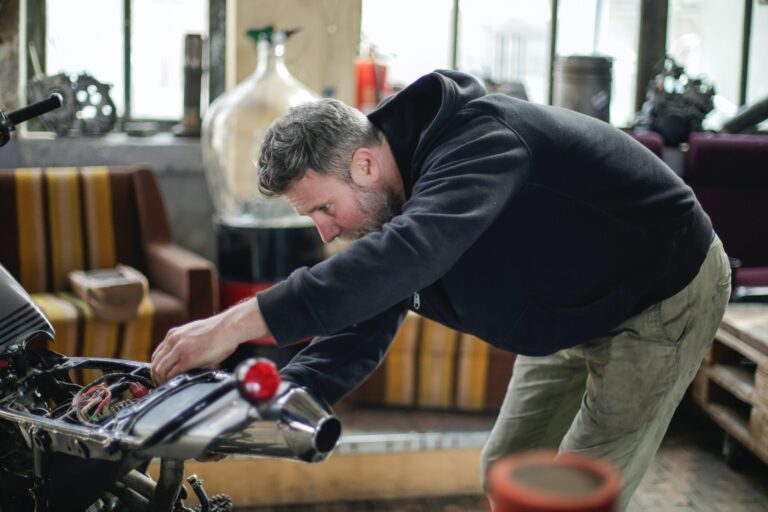Understanding Brake Boosters
To comprehend the importance of brake booster repair, it is essential to understand what a brake booster is and its significance in a vehicle’s braking system.
What is a Brake Booster?
A brake booster, as explained by HowStuffWorks, is a component of the braking system that utilizes a vacuum created by the engine to multiply the force applied to the brake pedal. This multiplication effect makes it easier for the driver to apply the brakes and brings the vehicle to a stop more efficiently. The brake booster acts as a force amplifier, reducing the amount of physical effort required by the driver to achieve effective braking.
Typically located between the brake pedal and the brake master cylinder, the brake booster plays a vital role in enabling safe and responsive braking. Without a properly functioning brake booster, the braking system’s performance might be compromised, leading to potential safety risks.
Importance of Brake Boosters
The brake booster is a critical component that enhances the overall performance and safety of a vehicle’s braking system. Its importance lies in the following factors:
-
Effortless Braking: By multiplying the force applied to the brake pedal, a brake booster enables the driver to exert less physical effort to slow down or stop the vehicle. This makes it easier to control the vehicle during emergency stops or in situations that require sudden braking.
-
Shorter Stopping Distance: A functioning brake booster helps reduce the stopping distance of a vehicle. By amplifying the force applied to the brakes, it allows for quicker deceleration, enhancing the vehicle’s ability to come to a halt promptly.
-
Responsive Braking: Brake boosters ensure a more responsive braking experience. When the driver presses the brake pedal, the booster instantly translates that input into increased brake pressure. This responsiveness helps maintain control over the vehicle and enhances overall driving safety.
Given the vital role that brake boosters play in ensuring effective braking, it is crucial to address any issues promptly and seek brake booster repair when necessary. Regular inspection and maintenance of the brake booster are essential to identify and resolve any potential problems that may compromise the braking system’s performance.
In the following sections, we will explore the signs of brake booster issues and delve into the diagnostic and repair processes involved in addressing these concerns. Whether you opt for DIY brake booster repair or seek professional assistance, understanding the importance of maintaining a properly functioning brake booster will help you preserve your safety on the road.
Signs of Brake Booster Issues
Recognizing the signs of brake booster issues is crucial for maintaining the safety and functionality of your vehicle’s braking system. Here are some common indicators that may suggest a problem with the brake booster:
Hard Brake Pedal
One of the primary signs of a failing brake booster is a hard brake pedal. When you press down on the brake pedal, it requires increased effort to bring the vehicle to a stop. This can be an indication of a damaged or worn-out brake booster (Family Handyman). If you notice that your brake pedal feels unusually firm or unresponsive, it’s essential to have your brake system inspected by a professional brake mechanic.
Increased Braking Effort
When a brake booster is functioning correctly, it provides power assistance to help you apply the brakes with minimal effort. However, if you find yourself needing to exert more force on the brake pedal to achieve the desired braking effect, it may be a sign of a faulty brake booster. Increased pedal effort can indicate a loss of power assist, which compromises the overall braking performance of your vehicle (HowStuffWorks).
Hissing Sound while Braking
A hissing sound when applying the brakes can be indicative of a vacuum leak in the brake booster. As the vacuum leak disrupts the proper functioning of the brake booster, air can escape, resulting in a distinct hissing noise. If you notice this sound when you press or release the brake pedal, it’s important to have your brake system inspected by a professional. Ignoring a vacuum leak can lead to further damage and compromise the effectiveness of the braking system (Family Handyman).
Longer Stopping Distance
A faulty brake booster can affect the stopping distance of your vehicle. If you notice that it takes longer for your vehicle to come to a complete stop, it could be a sign of a brake booster issue. A compromised brake booster reduces the effectiveness of the braking system, potentially increasing the risk of accidents. It’s crucial to address any concerns regarding the stopping distance promptly to ensure the safety of yourself and others on the road (Family Handyman).
If you experience any of these signs or suspect a problem with your brake booster, it’s essential to seek professional brake services. A qualified technician can diagnose the issue and recommend the appropriate brake booster repair or replacement if necessary. Taking prompt action can help preserve the safety and reliability of your vehicle’s braking system.
Brake Booster Repair
When it comes to maintaining the safety of your vehicle’s braking system, addressing brake booster issues promptly is crucial. Brake booster repair typically involves a diagnostic process to identify the problem, followed by the replacement of faulty components or, in some cases, the entire brake booster unit. Let’s take a closer look at the steps involved in brake booster repair.
Diagnostic Process
The first step in brake booster repair is to conduct a thorough diagnostic process to determine the cause of the issue. This can be done by inspecting the vacuum hoses and checking for leaks, testing the brake booster vacuum pressure, and checking the brake fluid level (RepairSmith). These checks help identify potential problems and provide a clear understanding of the condition of the brake booster.
Replacing Faulty Components
In many cases, brake booster repair involves replacing the faulty components rather than replacing the entire brake booster unit. Commonly replaced components include the vacuum hose and the check valve. The vacuum hose should be checked for any signs of damage or leaks. If a vacuum leak is detected, replacing the hose can often resolve the issue. Additionally, the check valve, which helps maintain vacuum pressure, should be inspected and replaced if necessary (Autos.com).
Brake Booster Replacement
If the diagnostic process reveals that the brake booster itself is faulty and cannot be repaired by replacing individual components, a brake booster replacement is necessary. The cost of a brake booster replacement can vary depending on the make and model of the vehicle, typically ranging from $300 to $700 (RepairSmith). It is important to have a professional brake mechanic perform the replacement to ensure proper installation and functionality.
By following the diagnostic process and addressing the specific issues with the brake booster, you can effectively repair the brake booster and restore the proper functioning of your vehicle’s braking system. It is crucial to prioritize safety and have any brake booster repairs performed by a qualified professional. Avoid putting pressure on the brake lines during the repair process to prevent damage, and always wear proper attire and eye protection to ensure personal safety (Autos.com).
Understanding the importance of brake booster repair and taking the necessary steps to address any issues promptly will help maintain the safety and reliability of your vehicle’s braking system. Regular brake system inspections and maintenance, along with prompt repair, are essential for a smooth and secure driving experience.
DIY Brake Booster Repair
If you’re a car owner looking to tackle brake booster issues on your own, performing a DIY brake booster repair can save you time and money. Here are the steps involved in the process:
Gathering Tools and Materials
Before starting the repair, it’s necessary to gather the tools and materials needed for the job. The specific tools required may vary depending on your vehicle’s make and model. However, common tools you may need include:
- Wrench set
- Screwdriver set
- Pliers
- Brake fluid
- Brake cleaner
- Replacement check valve
- Replacement brake booster
Initial Verification Checks
The initial verification checks involve checking the operation of the refill when the brake pedal is released. If the refill fails to occur, the brake hose should be checked and replaced if faulty. If the brake hose is intact but the vacuum system is faulty, it indicates that the brake booster needs immediate replacement. However, before replacing the entire booster, the status of the check valve should be checked.
Replacing the Check Valve
If the check valve is found to be faulty, it needs to be replaced. The check valve is responsible for maintaining the vacuum in the brake booster. If it fails, it can affect the performance of the brake booster. After replacing the check valve, perform the necessary checks to ensure that the pressure is correct.
Testing and Replacing the Brake Booster
If the pressure is not right after replacing the check valve, it indicates a faulty brake booster, and it should be replaced. When replacing the brake booster, it’s important to avoid putting pressure on the brake lines to prevent damage. Additionally, proper attire and eye protection should be used during the repair process.
Please note that DIY brake booster repair requires advanced mechanical knowledge and experience. If you’re unsure about your abilities or the extent of the brake booster issue, it’s always recommended to seek professional assistance. A brake repair shop or a brake mechanic can provide the necessary expertise to ensure the repair is done correctly and safely.
By following these steps, you can attempt a DIY brake booster repair. However, it’s essential to prioritize safety and ensure that you have the necessary skills and tools to complete the repair successfully. If you’re uncertain or encounter difficulties during the process, it’s best to consult a professional for assistance.
Remember, regular brake maintenance, including brake inspections, brake pad replacement, and brake fluid flushes, is crucial in preserving your safety on the road.
Professional Brake Booster Repair
When it comes to brake booster repair, it is crucial to have a professional mechanic inspect and address any issues. The brake booster plays a vital role in ensuring the proper functioning and safety of the braking system. Here, we will discuss the importance of professional inspection, repairing or replacing faulty brake boosters, and the cost associated with brake booster repair.
Importance of Professional Inspection
A professional inspection is essential because diagnosing brake booster issues requires expertise and specialized tools. During the inspection, a mechanic will thoroughly examine the brake booster, including the vacuum hoses and connections, to identify any leaks or malfunctions (HowStuffWorks). They will also test the brake booster vacuum pressure and check the brake fluid level to ensure everything is functioning optimally (RepairSmith).
By relying on a professional inspection, you can have peace of mind knowing that any underlying brake booster issues will be identified and addressed accurately. Promptly addressing these issues is crucial as a malfunctioning brake booster can significantly impact the performance of the braking system and compromise safety (RepairSmith).
Repairing or Replacing Faulty Brake Boosters
Once the inspection is complete, and a faulty brake booster has been identified, the next step is to either repair or replace the brake booster. The decision will depend on the extent of the damage and the feasibility of repair. In some cases, a malfunctioning vacuum booster valve can be replaced, restoring the brake booster to its proper functionality (Autos.com).
However, it is important to note that the status of the brake booster can only be confirmed after this repair. If the brake booster is beyond repair or deemed unsafe, it will need to be replaced to ensure the continued effectiveness of the braking system.
Cost of Brake Booster Repair
The cost of brake booster repair can vary depending on factors such as the make and model of the vehicle and the extent of the damage. Generally, the cost of a brake booster replacement ranges from $300 to $700. However, it’s essential to consult with a trusted mechanic or repair shop to get an accurate estimate based on your specific vehicle and situation (RepairSmith).
While the cost of brake booster repair may seem significant, it is a worthwhile investment in your safety and the performance of your vehicle’s braking system. Neglecting brake booster issues can lead to compromised braking ability, putting you and others on the road at risk. Therefore, it is crucial to address any brake booster problems promptly and rely on professional expertise to ensure the proper repair or replacement of the brake booster.
By entrusting your brake booster repair to a professional, you can have confidence in the expertise and experience of the mechanic, ensuring that your vehicle’s braking system operates at its best for optimal safety.
Safety Considerations
When it comes to brake booster repair, it is important to prioritize safety throughout the process. Repairing the brake booster involves working with critical components of the braking system, and taking necessary precautions can help prevent accidents and ensure a successful repair. Here are two key safety considerations to keep in mind.
Avoiding Damage to Brake Lines
During the brake booster repair process, it is crucial to avoid putting pressure on the brake lines to prevent damage. The brake lines carry brake fluid, which is responsible for transmitting hydraulic pressure to the brake system components. Damaging the brake lines can result in brake fluid leaks and compromise the effectiveness of the braking system.
To prevent damage to the brake lines, it is essential to handle them with care and avoid applying excessive force. Take extra precautions when working around the brake lines, ensuring that they are not twisted, bent, or kinked during the repair process. If you are unsure about the proper handling of brake lines, it is recommended to consult a professional brake mechanic.
Proper Attire and Eye Protection
When working on brake booster repair, it is important to prioritize personal safety by wearing proper attire and using eye protection. Brake repairs often involve working in cramped spaces and handling various components, which can pose risks if not approached with caution.
To protect yourself during the repair process, consider wearing mechanics gloves to provide grip and prevent injuries. Additionally, wearing eye protection, such as safety goggles, can shield your eyes from debris or any accidental splashes of brake fluid.
By wearing the appropriate attire and using eye protection, you can reduce the risk of injuries and ensure a safer brake booster repair experience.
Remember, if you are uncertain about performing brake booster repair on your own, it is always advisable to seek professional assistance from a certified brake repair shop. Professionals have the expertise and specialized tools to handle brake repairs safely and effectively, ensuring the integrity of your vehicle’s braking system.
In the next section, we will explore different types of brake boosters, including vacuum type boosters, hydro-boost brake boosters, and electro-hydraulic brake systems. Understanding these variations can provide valuable insights when it comes to choosing the right brake booster for your vehicle’s needs.
Types of Brake Boosters
Brake boosters play a crucial role in enhancing the braking performance of vehicles. There are different types of brake boosters available, each with its own unique characteristics and advantages. In this section, we will explore three common types of brake boosters: vacuum type boosters, hydro-boost brake boosters, and electro-hydraulic brake systems.
Vacuum Type Boosters
The most common type of brake booster found in passenger cars is the vacuum type booster. This type of booster is typically mounted on the firewall between the brake pedal and the brake master cylinder. It works by utilizing the vacuum created by the engine’s intake manifold to multiply the force applied to the brake pedal, reducing the foot pressure needed to bring the vehicle to a stop (BuyBrakes).
In applications where engine vacuum is insufficient, a vacuum pump may be employed to supply the necessary vacuum for proper booster operation. Vacuum type boosters are known for their reliability, effectiveness, and widespread use in various vehicle models.
Hydro-Boost Brake Boosters
Hydro-boost brake boosters are another type of brake booster commonly used in vehicles. Unlike vacuum type boosters, hydro-boost brake boosters utilize hydraulic pressure from the power steering pump for braking assistance. These boosters are mounted on the firewall and are beneficial in situations where engine vacuum may be weak or unavailable (BuyBrakes).
Hydro-boost brake boosters provide increased braking force and can deliver consistent performance even under demanding conditions. They are often found in larger vehicles, such as trucks and SUVs, where the demand for braking power is higher.
Electro-Hydraulic Brake Systems
An electro-hydraulic brake system, also known as “brake-by-wire,” is utilized in hybrid and electric vehicles. This advanced brake system combines electrical and hydraulic components to determine the necessary brake pressure at each wheel. By using sensors and electronic control units, the system can optimize braking performance and provide enhanced control over the vehicle’s braking dynamics (BuyBrakes).
Electro-hydraulic brake systems offer several advantages, such as regenerative braking, precise control, and the ability to integrate with other vehicle systems. These systems contribute to the overall efficiency and safety of hybrid and electric vehicles.
Understanding the different types of brake boosters is essential when it comes to brake booster repair and maintenance. Whether you have a vacuum type booster, hydro-boost brake booster, or an electro-hydraulic brake system, it is crucial to ensure that these components are properly inspected and serviced to maintain optimal braking performance. If you are experiencing any issues with your brake booster, it is recommended to consult a professional brake mechanic or visit a brake repair shop for a thorough brake system check and necessary repairs.







